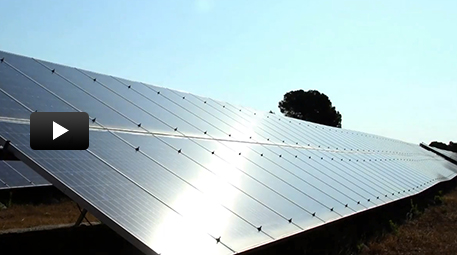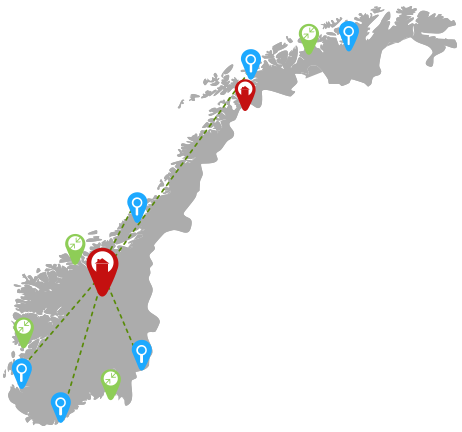Hentet fra pressemelding fra Mission Innovation: http://mission-innovation.net/2016/11/14/mission-innovation-ministers-gather-at-cop22-for-public-event/
Doubling of RD&D investments by 2020/2021
Under the Mission Innovation initiative, members have pledged to double their collective investments in energy RD&D funding by 2020/21. The Governments of Australia, Brazil, Canada, Chile, China, Denmark, France, Germany, India, Indonesia, Italy, Japan, Republic of Korea, Mexico, Norway, the Kingdom of Saudi Arabia, Sweden, the United Arab Emirates, the United Kingdom, and the United States announced Mission Innovation (MI) on 30 November 2015. The European Commission (on behalf of the European Union), Netherlands and Finland have all joined the initiative since its launch. Collectively, Mission Innovation members encompass over 80% of the world’s public funding for energy RD&D.
Seven Global Innovation Challenges
Innovation Challenges are global calls to action aimed at accelerating research, development, and demonstration (RD&D) in technology areas where MI members believe increased international attention would make a significant impact in our shared fight against climate change. The Innovation Challenges cover the entire spectrum of RD&D; from early stage research needs assessments to technology demonstration projects.
The Innovation Challenges were developed through a collaborative process between MI members. Engagement in an Innovation Challenge is entirely voluntary and is built around a coalition of interested MI members. With sufficient interest from MI members, new Innovation Challenges could be launched in the future.
Norway: Doubling Plans for public RD&D investments in environmentally friendly energy
|
The seven Innovation Challenges are the following:
- Smart Grids Innovation Challenge – to enable future grids that are powered by affordable, reliable, decentralised renewable electricity systems
- Off-Grid Access to Electricity Innovation Challenge – to develop systems that enable off-grid households and communities to access affordable and reliable renewable electricity
- Carbon Capture Innovation Challenge – to enable near-zero CO2 emissions from power plants and carbon intensive industries
- Sustainable Biofuels Innovation Challenge – to develop ways to produce, at scale, widely affordable, advanced biofuels for transportation and industrial applications
- Converting Sunlight Innovation Challenge – to discover affordable ways to convert sunlight into storable solar fuels
- Clean Energy Materials Innovation Challenge – to accelerate the exploration, discovery, and use of new high-performance, low-cost clean energy materials
- Affordable Heating and Cooling of Buildings Innovation Challenge – to make low-carbon heating and cooling affordable for everyone
These seven challenges are aimed at catalyzing global research efforts in areas that could provide significant benefits in reducing greenhouse gas emissions, increasing energy security, and creating new opportunities for clean economic growth. By doing so, MI members aim to encourage increased engagement from the global research community, industry, and investors, while also providing opportunities for new collaborations between MI members.
Smart grid that accommodate 100% renewable energy by 2030
The smart grid innovation challenge aims over the next decade to develop and demonstrate the use of smart grid technologies and storage in a variety of grid applications, including demonstrating the robust, reliable operation of MW-sized micro grids in diverse geographic conditions. By 2030, the objective is to develop technology solutions that can accommodate 100% renewable based power plants in large scale across the globe.
World electrical energy consumption is increasing at the rate of 1.4%/year1, with an associated increase in greenhouse gases (GHG) emissions that are negatively affecting the climate around the globe. Thus, a fundamental transformation of the world’s power systems is under way to deliver zero-emissions power to an increasingly electricity-hungry world.
For example, eighteen cities in the United States have committed to maximising the amount of energy they use from renewable energy, up from 25% today. Meeting this challenge requires a transition from the power grid that today relies on coal and gas power plants, to a future grid that can be largely powered by decentralized renewable energy sources, and which can dynamically adjust supply and demand in order to handle the intermittency of solar and wind power.
While the challenges are significant, so are the opportunities. By 2040, it is expected that zero-emission energy sources will make up 60% of installed capacity. Wind and solar will account for more than 60% of the new power generating capacity added worldwide. This represents more than 8 terawatts of generation capacity and about 7 trillion USD of the $11 trillion USD invested.3
Innovation in smart grid and storage technologies, and the development of community or city scale discrete grids powered largely or solely by renewables that can operate in parallel with, or independently from, the main grid (known as ‘renewable micro grids’), will help accelerate these developments.
Download the Smart Grids Innovation Challenge two-page overview. http://mission-innovation.net/wp-content/uploads/2016/11/Smart-grid-innovation-challenge.pdf
Off Grid Access to Electricity
The objective is to develop systems that enable off-grid households and communities to access affordable and reliable renewable electricity.
According to the IEA World Energy Outlook 2015, an estimated 1.2 billion people – 17% of the global population – did not have access to electricity in 2013. On average, these families spend between 1 and 2 USD/week just for lighting, using fossil fuels. The same IEA report identified 635 million people in Africa without access to electricity, and the World Bank estimates sub-Saharan Africa spends USD 10.5 bn/year on candles and kerosene for lamps. In other regions, isolated communities, for example on islands or in remote areas, are not connected to a large electricity grid and rely on often ageing diesel powered generators.
Rewable electricity systems (based on PV, wind, small hydro etc. depending on local resource) should respond to the needs of single families or remote communities (from the kilowatt level to 100s of kilowatts) without access to grid or still relying on fossil fuel.
Research and development (R&D) is needed to bring down the cost of these solutions and enhance the range of energy services they can provide, either to equip people with no access or to modernize existing systems by switching to renewable energy. In the short term, innovation on components (inverters, storage, remote monitoring and control…), efficient appliances, and systems design and optimization may reduce the cost of delivered electricity to consumers, meeting an increasing range of needs with payment options matching affordability. In the longer term, breakthrough technologies on storage could be incorporated into the systems to provide an even greater range of services to communities in order to support new economic activities enabled by electricity availability, for instance in the field of digital economy.
Experts from different Mission Innovation countries will be brought together in 2017 in order to identify and agree specific research and innovation needs for the different scenarios targeted in the Challenge (isolated households/communities with a range of uses and demand levels), and to determine a series of collaborative activities that will be pursued (such as an international contest on innovation on these solutions).
Download the Off Grid Innovation Challenge two-page overview. http://mission-innovation.net/wp-content/uploads/2016/11/Off-grid-innovation-challenge.pdf
Del på facebook
Del på linkedIn








